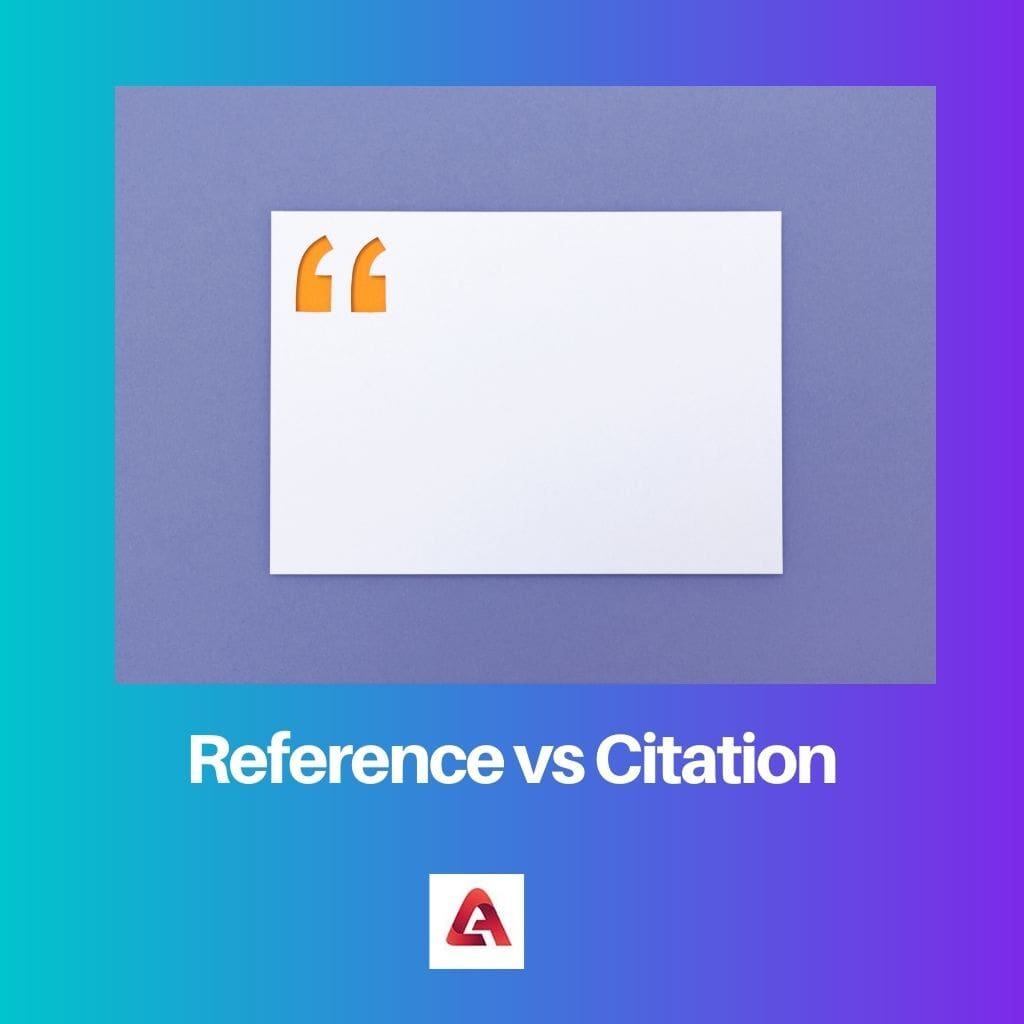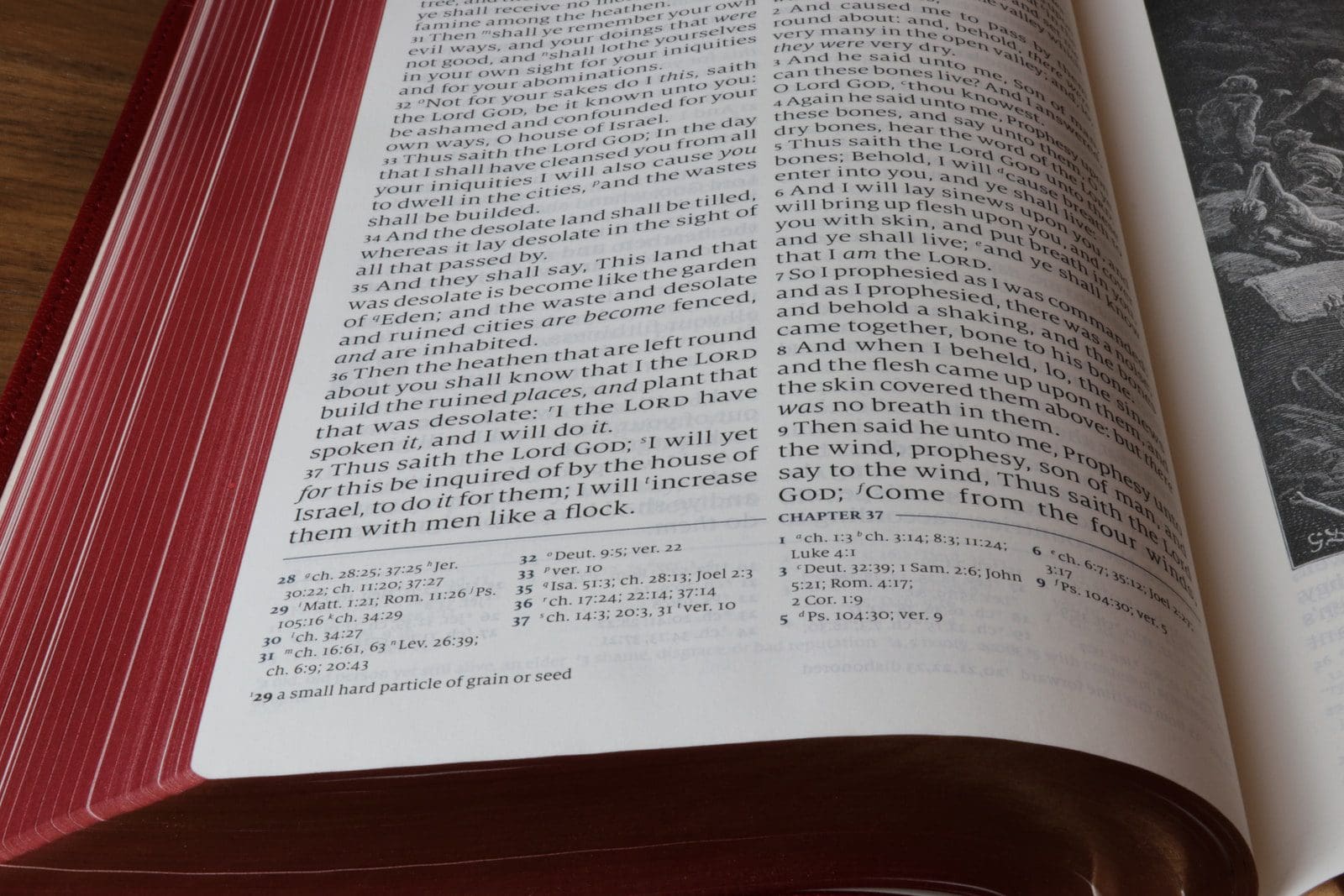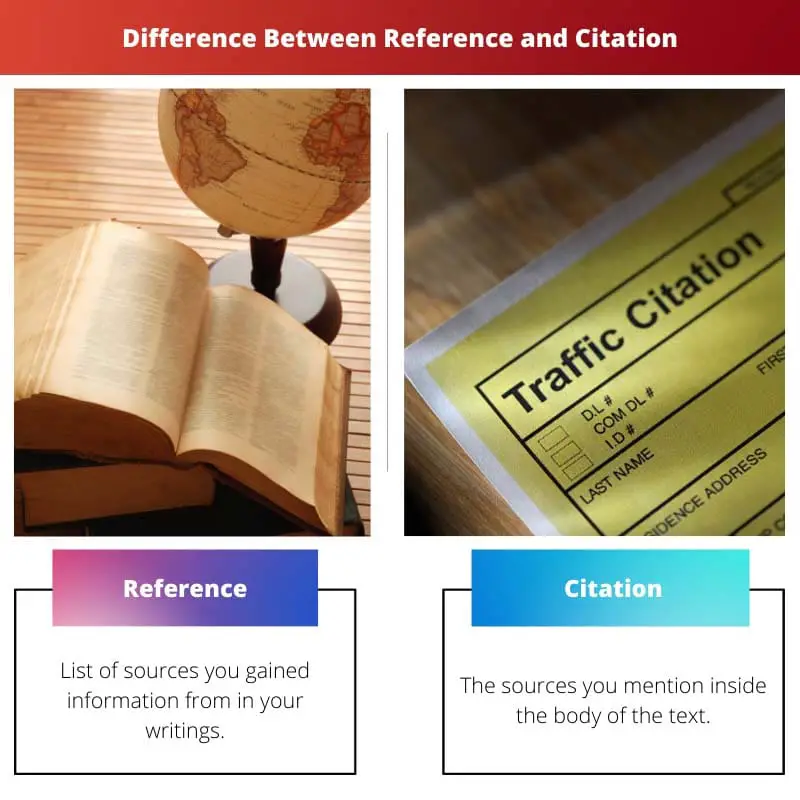A reference is a bibliographic entry providing the details of a source used in academic work, listed at the end of a document. A citation, on the other hand, is an in-text acknowledgment of a specific piece of information or idea borrowed from a source, accompanied by the author’s last name and the year of publication.
Key Takeaways
- A reference is a source of information used to support a writer’s claims, ideas, or arguments in a piece of writing. At the same time, a citation is the formal acknowledgment of a reference within the text.
- Citations follow specific formatting guidelines (e.g., APA, MLA, or Chicago style) and include the author’s name, publication date, and work title.
- Proper citation of references ensures intellectual honesty, gives credit to the original author, and allows readers to locate and verify the sources used in a written work.
Reference vs Citation
Reference is the source of information. When a writer uses the text or work of another writer, he/she must give reference to it. Reference is listed at the end of the document. Endnotes are used to mention a reference. When a writer mentions a source within a text, he/she then uses citation. Brackets are used to mention a citation.

Citations are all the sources you mention in the body of your writing. The information could be in direct quotes or paraphrased in your reports.
The reference table below shows the other features that differentiate between reference and citation.
Comparison Table
| Feature | Reference | Citation |
|---|---|---|
| Purpose | Provides full details of a source used in a written work | Briefly acknowledges a source used in a written work |
| Location | List at the end of the document (e.g., bibliography, works cited) | Included within the main body of the text (e.g., parentheses, footnotes) |
| Amount of information | Includes all relevant details, such as author(s), title, publication date, publisher, and page numbers | Typically includes only author(s) and publication date (or a number corresponding to a full reference list) |
| Length | Longer, providing full details | Shorter, offering brief information |
What is Reference?
Definition of Reference:
A reference, within the context of academic writing and research, serves as a comprehensive bibliographic entry providing detailed information about a source that has been consulted, cited, or referred to in a document. These sources can include books, journal articles, websites, reports, and other scholarly materials.
Components of a Reference:
- Author(s): The names of the individual(s) or organization responsible for creating the work being referenced. In scholarly articles, the author’s full name is provided, while in some cases, corporate authors or institutional affiliations may be listed.
- Title: The title of the source being referenced, whether it’s a book, article, report, or webpage. It should be formatted according to the citation style being used (e.g., APA, MLA, Chicago).
- Publication Information: This includes details such as the name of the publisher, publication date, edition (if applicable), and the place of publication. For journal articles, it includes the journal title, volume, issue, page numbers, and DOI (Digital Object Identifier) or URL.
- Additional Information (Optional): Depending on the citation style and type of source, additional details may be required, such as translators, editors, edition numbers, or series information.
Purpose of References:
- Credibility and Accountability: References serve to verify the information presented in a document by allowing readers to locate and evaluate the sources used. They provide transparency and accountability by acknowledging the intellectual contributions of others and avoiding plagiarism.
- Supporting Further Research: References enable readers to delve deeper into the topic by providing a roadmap to related literature. Researchers can use references to trace the development of ideas, identify seminal works, and explore different perspectives on a subject.
- Building on Existing Knowledge: By referencing existing literature, authors situate their work within the broader scholarly conversation, demonstrating how their research contributes to, challenges, or extends existing knowledge in the field. This intertextuality strengthens the academic discourse and fosters intellectual exchange.

What is Citation?
Definition of Citation:
A citation is a method of acknowledging and attributing the use of external sources of information within a written work. It involves referencing specific ideas, data, or quotations from these sources directly within the text, along with providing corresponding details about the source in a bibliography or reference list.
Components of a Citation:
- In-Text Citation: The in-text citation appears within the body of the text at the point where the referenced material is used. It includes the author’s last name and the year of publication enclosed in parentheses, e.g., (Smith, 2019). Depending on the citation style, page numbers may also be included for direct quotations.
- Bibliographic Details: In addition to the in-text citation, a full bibliographic reference for the source is included in a bibliography, reference list, or works cited page at the end of the document. This reference provides comprehensive information to enable readers to locate the source, including the author’s full name, title of the work, publication date, publisher information, and page numbers (for books and articles).
- Citation Styles: Different academic disciplines and publications adhere to specific citation styles, such as APA (American Psychological Association), MLA (Modern Language Association), Chicago, or Harvard. Each style has its guidelines for formatting citations and references, including variations in punctuation, capitalization, and the order of elements.
- Cross-Referencing: In more extensive works, such as theses, dissertations, or research papers, citations serve not only to acknowledge sources but also to support claims, arguments, or findings. Authors may cross-reference citations within the text to establish connections between different sources, demonstrate the depth of their research, or highlight the relevance of prior work to their own.
Purpose of Citations:
- Credit and Attribution: Citations give credit to the original creators or authors of ideas, concepts, data, or words used in a document. They acknowledge intellectual contributions and prevent plagiarism by clearly distinguishing between the author’s original work and borrowed material.
- Validation and Transparency: By providing citations, authors allow readers to verify the accuracy and credibility of the information presented in their work. Transparent referencing practices enhance the trustworthiness of research and facilitate scholarly communication by enabling others to replicate or build upon the findings.
- Contextualizing and Situating Research: Citations contextualize an author’s work within the broader scholarly conversation by demonstrating how it relates to and engages with existing literature. They showcase the lineage of ideas, theories, and methodologies, helping readers understand the intellectual landscape in which the research is situated.
- Facilitating Further Exploration: Citations provide readers with a pathway to explore related literature and delve deeper into the topic. By citing relevant sources, authors guide readers to additional resources for further study, enabling them to gain a more comprehensive understanding of the subject matter.

Main Differences Between Reference and Citation
- Reference:
- Provides detailed bibliographic information about a source used in a document.
- Listed at the end of the document in a bibliography or reference list.
- Includes elements such as author(s), title, publication information, and additional details depending on citation style.
- Serves to verify sources, support further research, and build on existing knowledge.
- Citation:
- Acknowledges the use of specific ideas, data, or quotations from external sources within the text.
- Appears directly within the body of the text, including the author’s last name and publication year in parentheses.
- Supports claims, arguments, or findings by attributing information to its original source.
- Helps give credit to original creators, validate claims, provide transparency, and facilitate further exploration of related literature.




